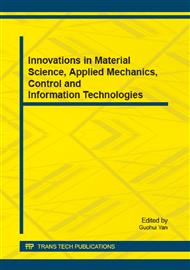[1]
D.S. Jiao, S.W. Ren, J. Li, et al. Journal of Materials Engineering (in Chinese). Vol. 10(2007), p.11.
Google Scholar
[2]
J.H. Zhang, L. Ren, L.F. Wang, et al. Aerospace Materials & Technology (in Chinese). Vol. 41(2011), p.79.
Google Scholar
[3]
A. Mostafa, A. Abouel-Kasem, M.R. Bayoumi, et al. Materials and Design. Vol. 30(2009), p.2721.
Google Scholar
[4]
S.L. Wang, P. Wang, T.H. Ding. Polymer Composites. Vol. 321(2011), p.29.
Google Scholar
[5]
Y. Huang, W. Lu, X.W. Zhao, et al. Robot (in Chinese). Vol. 33(2011), p.347.
Google Scholar
[6]
Y.G. Du, Y. J. Pan, J.M. Liu, et al. Chinese Journal of Scientific Instrument (in Chinese). Vol. 25(2004), p.215.
Google Scholar
[7]
M. Shimojo, A. Namiki, M. Ishikawa, et al. IEEE Sensors Journal. Vol. 4(2004), p.589.
Google Scholar
[8]
M. Tanaka, T. Iijim, Y. Tanahashi, et al. Journal of Materials Processing Technalogy. Vol. 181(2007), p.286.
Google Scholar
[9]
W.Y. Hu, L.L. Wang, L.J. Wu, et al. Polymer Materials Science & Engineering (in Chinese). Vol. 11(1995), p.106.
Google Scholar
[10]
W.Y. Hu, L.H. Zhao, L.J. Wu, et al. Journal of Applied Physics. Vol. 72(1996), p.866.
Google Scholar
[11]
Q. Zheng, J. F. Zhou, Y.H. Song. Journal of Materials Science. Vol. 19(2004), p.2625.
Google Scholar
[12]
P. Wang, T.H. Ding. Journal of Materials Science. Vol. 45(2010), p.3595.
Google Scholar
[13]
L.H. Wang, Y.Y. Han. Composites Part A. Vol. 47(2013), p.63.
Google Scholar
[14]
L.H. Wang, F.F. Ma, Q.S. Shi, et al. Sensors and Actuators A: Physical. Vol. 165(2011), p.207.
Google Scholar
[15]
B. Li, Y. Wang, N.S. Song. Journal of Functional Materials (in Chinese). Vol. 44(2013), p.1871.
Google Scholar
[16]
J.P. Song. China Elastomerics (in Chinese). Vol. 22(2012), p.19.
Google Scholar
[17]
Y.L. Cheng, Y.H. Song, Q. Zheng, et al. Chemical Journal of Chinese Universities (in Chinese). Vol. 26(2005), p.952.
Google Scholar
[18]
Q. Xie, J.L. Lou, F.X. Gan. Acta Physica Sinica (in Chinese). Vol. 49(2000), p.1191.
Google Scholar
[19]
Q. Xie, R. S. Liu, P. Peng, et al. Journal of Hunan University (Natural Sciences Edition) (in Chinese). Vol. 29(2002), p.68.
Google Scholar
[20]
Q. Xie, J.L. Lou, H.W. Huang, et al. Journal of Functional Polymers (in Chinese). Vol. 12(1999), p.414.
Google Scholar
[21]
J.Y. Wu, Y.H. Huang, J. Guo, et al. China Rubber Industry (in Chinese). Vol. 59(2012), p.276.
Google Scholar
[22]
K. Zhang, J.Y. Wu, Y.H. Huang, et al. Electronic Components & Materials (in Chinese). Vol. 31(2012), p.22.
Google Scholar
[23]
H.X. Guo, B.P. Luo, Y.Q. Li, et al. Electronic Components & Materials (in Chinese). Vol. 29(2010), p.4.
Google Scholar
[24]
L. Peng, Z.P. Zhang, C.F. Hu. Journal of Functional Polymers (in Chinese). Vol. 16(2003), p.229.
Google Scholar
[25]
Y.G. Zhang, Y. Huang, C. Lian, et al. Journal of Hefei University of Technology (Natural Science) (in Chinese). Vol. 35(2011), p.1452.
Google Scholar
[26]
Y. Huang, F. Gao, H.L. Qiu, et al. Journal of Functional Materials (in Chinese). Vol. 39(2008), p.177.
Google Scholar
[27]
Y. Huang, Y.G. Zhang, H.L. Qiu, et al. Chinese Journal of Scientific Instrument (in Chinese). Vol. 30(2009), p.949.
Google Scholar
[28]
H.L. Qiu, Y. Huang, X.L. Fu, et al. Instrument Technique and Sensor (in Chinese). Vol. 1(2009), p.1.
Google Scholar
[29]
Y. Huang, Y. Huang, P. Liu, et al. Chinese Journal of Sensors and Actuators (in Chinese). Vol. 22(2009), p.923.
Google Scholar
[30]
Q. Xie, R.S. Liu, Z.Y. Xu, et al. Polymeric Materials Science and Engineering (in Chinese). 14(1998), p.94.
Google Scholar
[31]
F. El-Tantawy. European Polymer Journal. Vol. 38(2002), p.567.
Google Scholar
[32]
R. Soltani, A.A. Katbab. Sensors and Actuators: A. Vol. 163(2010), p.213.
Google Scholar


